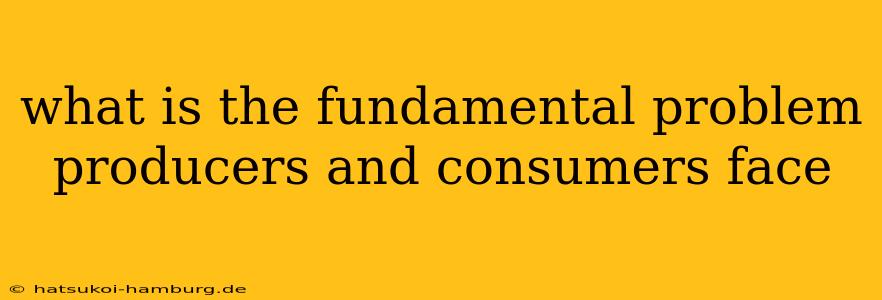Introduction:
Producers and consumers, the two fundamental actors in any economy, constantly grapple with a core issue: scarcity. This isn't simply about lacking enough resources; it's about the fundamental mismatch between unlimited human wants and the limited resources available to satisfy them. Understanding this problem is crucial to comprehending economic choices and behaviors. This article will explore how scarcity impacts both producers and consumers, forcing them to make difficult decisions and driving innovation.
Scarcity: The Root of Economic Decisions
What is Scarcity?
Scarcity means that there aren't enough resources – land, labor, capital, and entrepreneurship – to produce everything everyone wants. This basic economic principle is the driving force behind all economic activity. It compels producers to make choices about what to produce and how to produce it, and it forces consumers to make choices about what to buy and how much to spend.
How Scarcity Affects Producers:
Producers face the challenge of allocating limited resources efficiently to maximize profits. This involves:
-
Opportunity Cost: Every production decision means forgoing the opportunity to produce something else. Choosing to manufacture cars, for example, means not producing tractors with those same resources. Producers must carefully weigh the potential profits of different products.
-
Resource Allocation: Producers must determine the optimal combination of resources (labor, capital, raw materials) to use in production. This involves making trade-offs; using more labor might reduce the need for expensive machinery, but it might also increase labor costs.
-
Production Possibilities Frontier (PPF): The PPF illustrates the maximum amount of two goods that an economy can produce given its resources. It visually demonstrates the trade-offs producers must make when allocating resources. Any point inside the PPF represents inefficiency; any point outside is unattainable given current resources.
-
Technological Advancements: Producers constantly seek ways to improve efficiency and productivity through innovation and technology. This allows them to produce more with the same resources or to produce the same amount with fewer resources.
The Producer's Dilemma: Maximizing Output with Limited Resources
Producers are constantly searching for ways to overcome the constraints of scarcity. This involves strategic planning, efficient resource management, and adapting to changing market demands. The inability to satisfy every consumer's demand forces them to make difficult choices, prioritizing those products with the highest potential profit.
How Scarcity Affects Consumers:
Consumers also face the constraints of scarcity. Their limited budgets force them to make choices about how to allocate their resources:
-
Budget Constraints: Individuals have limited income and must choose how to spend it among various goods and services. This forces them to prioritize their wants and needs.
-
Consumer Preferences: Individual preferences play a crucial role in consumer choice. Consumers allocate their spending based on their own subjective valuations of different goods and services.
-
Price Signals: Prices act as signals to consumers, influencing their choices. Higher prices generally signal scarcity and discourage consumption, while lower prices encourage it.
-
Demand and Supply: The interaction of consumer demand and producer supply determines market prices and the quantity of goods and services produced.
The Consumer's Dilemma: Prioritizing Wants and Needs Within Budgetary Limits
Consumers face a constant struggle to balance their unlimited wants against their limited budgets. They must make rational choices, considering the relative value and price of different goods and services. Effective budgeting and wise consumption decisions are critical to making the most of limited resources.
Conclusion:
Scarcity is the fundamental problem that producers and consumers face in every economy. It creates the need for choices and drives innovation. Producers must efficiently allocate limited resources, while consumers must prioritize their wants and needs within their budgetary constraints. Understanding scarcity's impact is essential for navigating the complexities of economic decision-making, both individually and collectively. By acknowledging the fundamental role of scarcity, we can better appreciate the choices we make and the systems that shape our economic realities.
